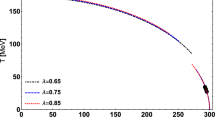Abstract:
We study the chiral phase transition at finite temperature in the linear sigma model by employing a self-consistent Hartree approximation. This approximation is introduced by imposing self-consistency conditions on the effective meson mass equations which are derived from the finite temperature one-loop effective potential. It is shown that in the limit of vanishing pion mass, namely when the chiral symmetry is exact, the phase transition becomes a weak first order accompanying a gap in the order parameter as a function of temperature. This is caused by the long range fluctuations of meson fields whose effective masses become small in the transition region. It is shown, however, that with an explicit chiral symmetry breaking term in the Lagrangian which generates the realistic finite pion mass the transition is smoothed out irrespective of the choice of coupling strength.
Similar content being viewed by others
Author information
Authors and Affiliations
Additional information
Recieved: 19 September 1997 / Revised version: 30 October 1997
Rights and permissions
About this article
Cite this article
Roh, HS., Matsui, T. Chiral phase transition at finite temperature in the linear sigma model. EPJ A 1, 205–220 (1998). https://doi.org/10.1007/s100500050050
Issue Date:
DOI: https://doi.org/10.1007/s100500050050



